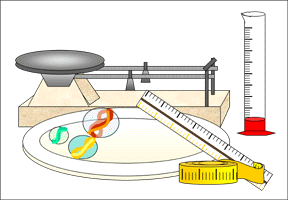 |
 |
|
|
|
|
Contributed by: Kentucky Department of Education (KDE) Description: Students study 3 marbles of different sizes. They make observations
and measurements, organize their data, and design an experiment
to answer questions posed. Super Toys is a company that manufactures toys. The company has
been making only the middle-sized marbles you see on your plate.
Marbles are made by pouring melted glass into molds. The company
melts enough glass in each container to make 100 middle-sized marbles
each time. How many small marbles can be made from one container
of glass? How many large marbles can be made from one container
of glass?
National Science Education Standards: 1.2 Plan and conduct an investigation. In the earliest years, investigations are largely based on systematic observations. As students develop, they may design and conduct simple experiments to answer questions. The idea of a fair test is possible for many students to consider by fourth grade. 1.4 Use data to construct a reasonable explanation. This aspect of the standard emphasizes the studentsí thinking as they use data to formulate explanations. Even at the earliest grade levels, students should learn what constitutes evidence and judge the merits or strength of the data and information that will be used to make explanations. After students propose an explanation, they will appeal to the knowledge and evidence they obtained to support their explanations. Students should check their explanations against scientific knowledge, experiences, and observations of others. 1.5 Communicate investigations and explanations. Students
should begin developing the abilities to communicate, critique,
and analyze their work and the work of other students. This communication
might be spoken or drawn as well as written. National Council of Teachers of Mathematics:MEAS1: Understand measurable attributes of objects and
the units, systems, and processes of measurement: RP2: Make and investigate mathematical conjectures:
COM1: Organize and consolidate their mathematical thinking
through communication: This task is designed to take students approximately 40-50 minutes
to complete. Students work together for up to 20 minutes. They are instructed
to notify you when finished with the group work, and then to go
on to the individual work beginning with question #1. If students
are still working together 20 minutes after the testing begins,
instruct them to cease their group work and begin individual work.
At this point, they may no longer talk. Whether or not they are
just beginning their individual work, remind students that they
now have about 25 minutes to complete the individual activity.
Advance Preparation: None is required. Safety:
Extensions/modifications:
Advanced Preparation Set Up:Organize student work station.
|
